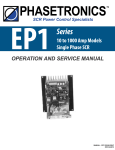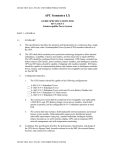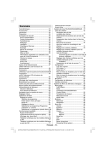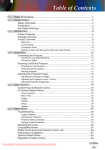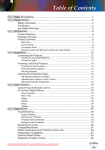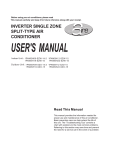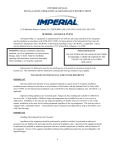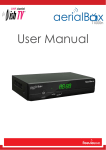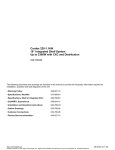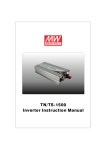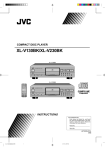Download PHASETRONICS
Transcript
PHASETRONICS SCR Power Control Specialists EP1 Series - Power Control Single Phase SCR 85 to 1000 Amps OPERATION & SERVICE MANUAL Phasetronics, Inc. P.O. Box 17159 13214 - 38th Street North Clearwater, FL 34622-0159 (813)573-1900 FAX(813)573- 1803 Table of Contents Chapter 1: Introduction ................................................................................................. 1 1.1 General 1.2 Receiving and Unpacking 1.3 Warning Chapter 2: Specifications ............................................................................................ 2 2.1 Specifications 2.2 Protective Networks 2.3 Ambient Temperature 2.4 Cooling Chapter 3: Installation .................................................................................................. 3 3.1 Location 3.2 Initial Unit Inspection 3.3 Warning 3.4 Mounting and Cleaning 3.5 Mounting Enclosure Chapter 4: Connections ............................................................................................... 4 4.1 Control Connections 4.2 Soft Start (Standard) 4.3 Power Connections 4.4 Control Options 4.5 Current Limit (Option C) Chapter 5: Start-up ....................................................................................................... 6 5.1 Manual Control 5.2 Automatic Control 5.3 Power-on Soft Start 5.4 Command Signal Change Soft Start (Option S) 5.5 Current Limit (Option C) 5.6 Current Trip (Option T) Chapter 6: Diagrams .................................................................................................... 7 6.1 Mother Board (85 thru 1000 Amp Units) 6.2 EP1 Series Option Board 6.3 Schematic 6.4 Dimension Configurations Chapter 7: Troubleshooting ...................................................................................... 12 7.1 Failure Analysis 7.2 SCR Testing Procedure 7.3 Replacing Printed Circuit Boards 7.4 Replacing SCR Device Chapter 8: Spare Parts............................................................................................... 15 8.1 SCRs 8.2 Main Circuit Board Chapter 9: Options .................................................................................................... 16 9.1 Soft Start (Option S) 9.2 Current Limit (Option C) 9.3 Current Trip (Option T) 9.4 Line Voltage Regulation (Option R) EP1 Series SCR Power Control Chapter 1 - Introduction This chapter is a brief introduction to the EP1 Series SCR power controls. 1.1 - General The EP Series of Phase Angle SCR Power Controls assures smooth proportional output power from 0 to 100%. This high quality SCR control is offered in a single phase with a variety of options. These options include current limit, current trip, voltage regulation, soft start on signal change and I2t fusing. The unit is ideally suited for all resistive and inductive loads. The soft start feature assures a slow rising output voltage to prevent an inrush on inductive or variable resistance loads. The control input is adjustable to match all standard temperature and process controllers. The control signal sensitivity is adjustable by gain and offset potentiometers. The unit can also be controlled from an external manual potentiometer. MOVs(standard) protect the SCRs from transient voltages. False firing (dv/dt) protection is also standard. 1.2 - Receiving Upon receipt of this product you should immediately do the following: • Inspect the unit for possible shipping damage (if damaged, you should notify the freight carrier and file a claim within 15 days of receipt) • Verify the model number on the unit matches up with your purchase order 1.3 - Warning! DO NOT SERVICE EQUIPMENT WITH VOLTAGE APPLIED! Unit can be a source of fatal electrical shocks! To avoid shock hazard, disconnect main power before working on unit. -1- EP1 Series SCR Power Control Chapter 2 - Specifications 2.1 - Specifications External Inputs Milliamp Input 4-20 mA Input Impedance - 250 ohms Analog Input 0-10 Vdc Signal / 0-5 Vdc Signal - 100k ohms input impedance Manual Control 10k ohm, 2 watt potentiometer, linear taper (customer provided) Output Current Rating 10 to 1000 Amps Output Stage Back to Back configuration AC Supply Voltage 120/208/240/308/415/480/575 Vac(+10% to -15%, 50/60 Hz) * Type of Loads Resistive / Inductive / Lamp Factory set for initial half-second of operation of power on. Field adjustable via potentiometer from 0.2 seconds to 30 seconds A combination of a high-potential gate pulse and a rapid rise time is used to prevent SCR damage due to di/dt stress Soft Start Hard Firing Gate Pulse Input Adjustments Gain 4-20mA, 0-5 Vdc, 0-10 Volts Offset 50% of gain maximum Regulation (Option R) Protective Networks Optional feature to provide average load voltage regulation of plus or minus 2% for +10% to -10% of gain maximum Optional Fusing I2t fuse protects against short-circuit overloads (Option F) Transient Voltage Suppressor SCR Peak Inverse Voltage (PIV Rating) Integral MOV (Metal Oxide Varistor) protects against high potential transient voltage RC Snubber RC snubber networks prevent false firing due to dv/dt characteristics 2.5 times line rating (minimum) Operating range is from 0°C thru 40°C (32°F thru 104°F) Ambient Temperature * Dependent on model configuration 2.2 - Protective Networks Transient Voltage Suppressor (Standard) - Integral MOV (Metal Oxide Varistor) protects against high potential voltage spikes. RC Snubber (Standard) - RC Snubber networks are used to prevent false firing due to dv/dt characteristics. SCR Peak Inverse Voltage (PIV Rating) Line Voltage C ontinuous SC R R ating 120 - 4 80 120 0 Vo lts 57 5 150 0 Vo lts 2.3 - Ambient Temperature Ambient temperature operating range 0 to 40 degrees C (32 to 104 degrees F). Output current rating decreases by 10% for each 5 degrees C rise (9 degrees F) in ambient temperature over 40 degrees C (104 degrees F) to a maximum of 60 degrees C (140 degrees F). Transportation and storage range: -30 to 65 degrees C (-30 to 149 degrees F). 2.4 - Cooling Units rated from 10 to 175 Amps are convection cooled. Units rated at 225 Amps and above are fan cooled and have a thermostat that will shut down on over temperature. -2- EP1 Series SCR Power Control Chapter 3 - Installation 3.1 - Location Proper location of the EP1 Series is necessary to achieve specified performance and normal operation lifetime. The EP1 Series should always be installed in an area where the following conditions exist: • Ambient operating temperature: • • • • • Enclosed unit: 0 to 40 degrees C (32 to 104 degrees F) - Type 1 ventilated enclosure Chassis unit: 0 to 50 degrees C (32 to 122 degrees F) Protected from rain and moisture Humidity: 5 to 95% non-condensing Free from metallic particles, conductive dust and corrosive gas Free from excessive vibration (below 0.5G) Open panel units must be mounted in the appropriate type of enclosure. Enclosure size and type must be suitable to dissipate heat generated by the SCR power control. (NEMA 1 style enclosures can be forced ventilated to reduce size.) Use the following formulas for sizing non-ventilated enclosures: ð Units maximum current (FLA) x 1.5 = watts then watts / 10 = sq. ft. of exposed area Non-vented stainless steel ð enclosures ( FLA10x 1.5) x 1.5 = sq. ft of exposed area Non-Vented painted metal enclosures 3.2 - Initial Unit Inspection Prior to installing the EP1 Series unit make a complete visual check of all the equipment for possible damage in shipping and handling. Report damage immediately before attempting to run unit. Check for loose mechanical assemblies or broken wires which may have occurred during transportation or installation. Loose electrical connections will increase resistance and cause unit to function improperly. Prior to beginning the installation verify that the EP1 Series unit is rated for the proper voltage and that the unit is rated for the appropriate load current. 3.3 - Warning! Do not service equipment with voltage applied! Unit can be source of fatal electrical shocks! To avoid shock hazard, remove all sources of power before working on controller. Warning labels must be attached to terminals, enclosure and control panel to meet local codes. 3.4 - Mounting and Cleaning If mounting the EP1 Series unit in an enclosure requires drilling or punching holes in the enclosure, cover the electrical assembly to prevent metal filings from becoming lodged in areas which can cause clearance reduction or actually short out electronics. After work is complete, thoroughly clean the area and reinspect the EP1 Series unit for foreign material. Make sure there is sufficient clearance (six inches) all around the EP1 Series unit for cooling, wiring and maintenance purposes. To maximize effective air flow and cooling, the unit must be installed with its heat sink ribs oriented vertically and running parallel to the mounting surface. If unit has a fan, install unit so the fan blows upward vertically. In dirty or contaminated atmospheres the unit should be cleaned on a regular basis to insure proper cooling. Do not use any chemicals to clean the unit; to remove surface dust, use 80 to 100 psi clean dry compressed air only. A three inch high quality dry paint brush is helpful to loosen up the dust prior to using compressed air on the unit. -3- 3.5 - Mounting Enclosure 85, 100, 150, 225 and 135 Amp units require a 120 cfm box ventalation fan for NEMA 1 enclosures. 500 Amp and larger units require a 240 cfm vent fan. See example below. Box 6″″ 6″″ 12345678901234567890 12345678901234567890 12345678901234567890 12345678901234567890 12345678901234567890 12345678901234567890 12345678901234567890 12345678901234567890 12345678901234567890 12345678901234567890 12345678901234567890 12345678901234567890 12345678901234567890 12345678901234567890 12345678901234567890 12345678901234567890 12345678901234567890 12345678901234567890 12345678901234567890 12345678901234567890 12345678901234567890 12345678901234567890 12345678901234567890 12345678901234567890 12345678901234567890 12345678901234567890 12345678901234567890 12345678901234567890 12345678901234567890 EP1 Unit 6″″ Note: 6″″ Fan 12 12 12 12 12 12 12 ← Type 1 Box size should be selected incoordination with minimum field wiring bending space requirements per local and National Electrical Codes. (NEC Article 373 and table 373-6A) -4- Air Flow EP1 Series SCR Power Control Chapter 4 - Connections 4.1 - Control Connections 4.1.1 Manual Control 1. If manual potentiometer is not used proceed to "Automatic Control". Manual potentiometer does not have to be connected for unit to operate. 2. Connect manual potentiometer to TB2-3(wiper), TB2-4(high),and TB2-6(low) per connection diagram. See figure 1 for connection & figure 3 for jumper locations. 3. Manual potentiometer is 10K ohm, 2 watts linear taper. 4. If you are using only manual control, proceed to power connections page 6. (high) (wiper) (low) Figure 1 - Manual Connections 4.1.2 Automatic Control 1. Connect DC voltage or milliamp input signal to pins 1(positive) and 2(negative) on TB2. You must select the proper jumper for 420 mA*, 0-5 Vdc or 0-10 Vdc. See location of jumpers on main logic board diagram section 6.1. 2. If manual and automatic control are both used, consider using an external auto/manual switch to prevent the manual setting from overriding the automatic signal. See location of jumpers and pins figure 3. Figure 2 - Automatic Connections 0-10 Vdc connection jumper X3 installed mA connection * 4-20 jumper X1 installed (factory setting) 0-5 Vdc connection jumper X2 installed Control Board Layout Figure 3 - TB2 Connections 4.2 - Soft Start (Standard) The standard soft start ramp adjustment is factory set (P3) for 0.5 seconds. The soft start ramp time can be increased to a maximum of 30 seconds by adjusting P3 in a clockwise(CW) direction. Note: Soft start is active only when initial power is applied and a command signal is present. It has no effect on control signal change. See Option S - Section 9.1 if soft start is required on restart of mA signal or when lockout is released. -5- 4.3 - Power Connections 1. Connect line 1 and supply side of load to power terminals. See figure 4 below. 2. Connect line 2 (using 18-22 gauge wire) to terminal 6 on TB1(EPCL1000). If option is present, connect line 2 to terminal 7 of TB2 on option board. See figure 4 and 5 below. 3. Connect line 2 to the return side of load. Main Logic Board L2 connection (if no option card is present) L1 (Hot) T1 (To Load) Figure 4 - Power Connection (no option card) Option Card (mounted on main logic board when options are ordered) L2 Connected to TB2-7 on option card Figure 5 - Power Connection (with option card) 4.4 - Control Options O ption Letter O ption Nam e C C urrent Lim it This option w ill lim it the output current at a preset level, adjustable from 0-110% of controller rating. (C u rrent lim it w ill override control input signal to lim it current output) T C urrent Trip A djustable from 50-200% for instantan eo us trip if current exceeds set level. U nit is connected for m anual reset. C urrent transform er includ ed . F F using This provides an integ ral I2t fu se w hich protects against short-circuit. S Description P rovides soft start on loss of com m and signal. A llow s O ptional S oft Start unit to ra m p up on a loss of com m and signal. 4.5 - Current Limit (Option C) Current limit is typically adjusted for full rated current, therefore appropriate load must be used for this adjustment to function properly. 1. Apply input control signal to achieve full output. 2. Adjust Current Limit potentiometer (P4 on option board) to desired level. Counter-clockwise(CCW) rotation of potentiometer will decrease output current level (lower the current limit set point). -6- EP1 Series SCR Power Control Chapter 5 - Start-up 5.1 Manual Control The following procedure is used for manual control start-up for the EP1 Series SCR Power Control. 1. If the unit has a milliamp or voltage input and a manual control potentiometer is also used, set the milliamp or voltage input signal to minimum (0). 2. Slowly rotate manual control potentiometer in a clockwise(CW) direction. Output voltage should slowly increase with potentiometer rotation. 3. If output voltage appears to be normal, turn the manual control fully counter-clockwise(CCW) (OFF). Note: If the unit is connected for manual control only and optional current limit is provided, proceed to current limit start-up procedure (Section 4.5 page 6). If operating under manual control only, you have completed start-up. 5.2 Automatic Control The following procedure is used to set up the EP1 Series SCR Power Control for automatic operation. 1. Gain and Offset Adjustments are factory calibrated and shipped to accept 4-20mA DC input signal. If voltage input signal is used change jumper selector on main logic board. (See page 8) 2. Apply milliamp or voltage input signal and observe output. Unit output should be proportional to control input signal. If a different control signal is desired, or you want to check calibration, proceed as follows: • Apply minimum desired input control signal (example. 4mA). • Adjust Offset potentiometer (P1) until output voltage is at desired minimum output. Clockwise(CW) rotation will decrease output (Increase the amount of offset). • Apply maximum desired input control signal (example 20mA). • Adjust Gain potentiometer (P2) until output voltage is at desired maximum output. Clockwise(CW) rotation will increase output. If required repeat these steps to obtain specific output levels. • When using the 0-5 or 0-10Vdc automatic signals, optimum performance can be achieved by re-zeroing the unit using the offset potentiometer P1. 5.3 Power-on Soft Start When initial power is applied and a command signal is present, the output voltage is ramped to the desired commmand signal level over an adjustable interval. The interval can be adjusted from 0 to 30 seconds using potentiometer P3 on the main logic board. 5.4 Command Signal Change Soft Start (Option "S") Provides soft start on a reapplication of command signal. The unit is set up so that either of these two soft start modes can be disabled if desired. The unit will ramp up on a reapplication of command signal if this signal is brought to 0%. The interval can be adjusted from 0-30 seconds using P2 on the option card. 5.5 Current Limit (Option "C") Adjustable from 0-110% of unit rating. Current limit will override control input signal to limit the output current. Current transformer included. The level of current limit can be adjusted from 0-125% using P4 on the option card. 5.6 Current Trip (Option "T") Adjustable from 50-200% for instantaneous trip if current exceeds set level. Unit can be connected for manual or automatic reset. Current transformer included The level of current trip can be adjusted using P3 on the option card. -7- EP1 Series SCR Power Control Chapter 6 - Diagrams 6.1 - Main Logic Board for EP1 Series (85 thru 1000 Amp Units) PCL1002 Note: 380, 575 volt units are not dual connectable. 415 volts is dual connectable (208/415). -8- 6.2 - EP1 Series Option Board PCM1603 Note: All Options are shown here (P1, P2, P3 & P4). Individual configurations may be different depending on the type of options purchased. -9- 6.3 - Schematic - 10 - 6.4 - Dimension Configurations E P 1 - xx Amp A B C* H W D E P 1 - xx10(F ) 10 5.53 5.281 0.221 6 5 .75 4.04 E P 1 - xx25(F ) 25 5.53 5.281 0.221 6 5 .75 4.04 E P 1 - xx50(F ) 50 8.25 6.37 0.28 8.75 7 4.63 E P 1 - xx85(F ) 85 9.5 9 0.31 11 .5 9 .88 5.73 E P 1 - xx100(F ) 100 9.5 9 0.31 11 .5 9 .88 5.73 E P 1 - xx150(F ) 150 8 8 0.31 11 .5 11 8.38 E P 1 - xx225(F ) 225 8 8 0.31 12.3 11 8.38 E P 1 - xx350(F ) 350 8 8 0.31 12.3 11 8.38 E P 1 - xx500(F ) 500 19.37 9.25 0.44 21 11 10 E P 1 - xx650(F ) 650 E P 1 - xx800(F ) 800 E P 1 - xx1000(F ) 1000 xx = C all F actory * C = Mounting Hole Diameter (F) = Unit may include optional fuse Dimensions subject to change 12 = 120 Volts 20 = 208 Volts 24 = 240 Volts 38 = 380 Volts 41 = 415 Volts 48 = 480 Volts - 11 - EP1 Series SCR Power Control Chapter 7 - Troubleshooting 7.3 - SCR Testing Procedure Remove line power from the unit and lock out! Disconnect load and line leads! Remove line power from the unit and lock out. Disconnect the load and line leads. Disconnect SCR connections to the main circuit board. Note the type of color coding of the wires going to the SCR plug. Phasetronics uses two possible configurations. The first configuration consists of 4 wires color coded black, yellow, grey and white. The second configuration consists of 4 wires color coded red, white, red, white. The testing procedure for SCRs is comprised of two separate tests. The first procedure tests the anode to cathode integrity of the SCR by performing the following ohm checks: + Lead - Lead G ood C onsult Factory L1 L ug T 1 Lug G re ater than 10 k oh m Less than 10 k ohm The second procedure tests the gate to cathode integrity of the SCR. Place the leads of an ohm meter into the receptacle that was unplugged from the main circuit board. Ohm the pair of wires on one end of the plug (black/yellow or grey/white). Then ohm the pair of wires on the other end of the plug (black/yellow or grey/ white). The chart below indicates good verses bad readings. F or w ire that is color coded black, yellow, gray an d w hite + L ea d - L e ad G oo d Bad G ra y W hite B e tw e e n 5 a n d 1 0 0 o h m s Le ss th an 5 o r g re a te r tha n 1 0 0 oh m s G ra y W hite B e tw e e n 5 a n d 1 0 0 o h m s Le ss th an 5 o r g re a te r tha n 1 0 0 oh m s For w ire that is color cod ed red, w hite, red and w hite + L ea d - L e ad G oo d Bad Red W hite B e tw e e n 5 a n d 1 0 0 o h m s Le ss th an 5 o r g re a te r tha n 1 0 0 oh m s Red W hite B e tw e e n 5 a n d 1 0 0 o h m s Le ss th an 5 o r g re a te r tha n 1 0 0 oh m s Note: If any of the above readings are out of specification, replace the faulty SCR. 7.4 - Replacing Printed Circuit Boards The printed circuit boards are not intended to be field repaired. If the board is faulty, the entire board should be replaced using the following procedure: (Important ! Use ESD Precautions any time you replace circuit boards) 1. Remove power from the unit and lock out. 2. Remove plug and tag plug with connector number. 3. Remove control wires from terminals and tag wires with terminal numbers. 4. Note the settings of all potentiometers and jumpers (if applicable). 5. Remove mounting screws. 6. Remove old printed circuit board. 7. Mount new printed circuit board. - 12 - 8. Install mounting screws. 9. Set the potentiometers and jumpers on the new board to the same positions as on the old board (if applicable). 10. Install control wires in terminals matching tagged numbers. 11. Install plug matching tagged numbers. 7.5 - Replacing SCR Device Three types of SCRs are used in Phasetronics EP1 Series depending on the current rating of the SCRs. Stud and isolated SCRs are used in smaller units and "hockey puck" type SCRs are used in larger units. 7.4.1 - Changing an Isolated SCR 1. Remove both line and control power from unit, tag and lock out. Warning! Failure to remove both line and control power before starting this procedure may cause personal injury or death. 2. Label location of wires connected to SCR. 3. Remove mounting screws, lugs and associated wiring from existing SCR. 4. Make sure the surface to which the power module mounts is clean and free from dirt, nicks, and scratches. 5. Apply thermal grease uniformly along the length of the power module. Spread the grease thinly (3 mil thick) to cover completely the base of the power module and minimize air pockets. Grease must be free of contamination. 6. Replace screws and tighten down firmly. 7. Reconnect all busbars, lugs and wires. Check to make sure gate and cathode are wired correctly. Main Circuit Board Destination Pin 1 Load Gate Pin 2 Load Cathode (Output Load Lug) Pin 5 Line Gate Pin 6 Line Cathode (Input Line Lug) 8. After verifying that all wiring is correctly connected, apply power and test. 7.4.1 - Changing an Isolated SCR 1. Remove both line and control power from unit, tag, and lock out. Warning! Failure to remove both line and control power before starting this procedure may cause personal injury or death. 2. Phasetronics uses two type of clamps with gauges for reading the amount of torque on the device. The first type of torque gauge uses a spin washer. When the proper torque is applied, the washer will be free to spin. The second type of torque gauge uses a step indicator on the end of the lever. Before proceeding, note the type of clamp used and, if the clamp has a step indicator, document the position of the indicator before removing the clamp to facilitate proper torquing of the new SCR device. - 13 - 3. Label location of wires connected to SCR. 4. Remove any lugs, MOVs, snubbers, printed circuit boards and associated wiring that may get in the way of reaching the faulty SCR. Document the location and wiring of all parts before removing them to facilitate the re-installation of the devices later. 5. Document the position of the indicator on the SCR clamp. Then remove top clamp holding SCR stack together. Remove the top heatsink. 6. Remove faulty SCR device noting the direction the SCR is oriented. The new SCR puck must be inserted in the same direction. 7. Make sure the SCR mounting surface, tools and hands are clean and free from dirt, nicks, and scratches. Do not sand or scrape SCR mounting surface. If necessary super fine Scotch Brite pad can be used to clean the heatsink before installing the new SCR. 8. Apply a thin (3 mil thick) layer of thermal grease uniformly along both sides of the SCR. Spread the grease to cover the entire surface of both sides of the SCR in a manner that minimizes air pockets. The grease must be free of contamination. 9. Locate the centering pin in the bottom of the heatsink and center it in the SCR hole making sure that the SCR is pointed in the same direction as the SCR which was removed in step 6. Locate the centering pin in the top heatsink and center it in the SCR hole. Hand tighten the clamps evenly so that the same number of threads appear at both ends of the U-clamp. Tighten the clamp nuts 1/4 turn at a time alternating sides of the U-clamp until the correct torque is reached. Check the gauge or spin washer every time the clamp nuts are tightened 1/4 turn to ensure that the SCR is not over torqued. The torque gauge reading should be similar to the initial reading taken in step 2. If the clamp uses the spin washer type of gauge, verify that the washer spins freely after torquing down the clamp. Once proper torque is reached make sure that the SCR pucks are securely held between the heatsinks. 10. Replace any lugs, MOVs, snubbers, printed circuit boards and associated wiring that was removed in step 4. 11. After verifying that all wiring is correctly connected, apply power and test unit. - 14 - EP1 Series SCR Power Control Chapter 8 - Spare Parts SCR Devices U nit R ating (A m ps) 120-480 Vo lts P hasetro nics Part # 575 Volts P hasetronics Part # 20 25 -0040-1200S D 25-004 0-1500S D 40 25 -0055-1200S D 25-0050-15 00S D 75 25 -0090-1200S D 25-0090-15 00S D 110 25-0940-1200 25-0940-1500 140 25-0940-1200 25-0940-1500 175 25-0940-1200 25-0940-1500 225 25-0940-1200 25-0940-1500 300 25-0940-1200 25-0940-1500 400 25-0940-1200 25-0940-1500 500 25-2170-1200 25-2170-1500 600 25-2170-1200 25-2170-1500 MOV Devices U nit C urrent R ating Voltage Phasetronics Part # Voltage Phasetronics Part Num ber 1 20, 2 08, 2 40 50-040 -0250 120 P T R 14 00-1 20 2 77 50-040 -0510 208 P T R 14 00-2 08 3 80, 4 16, 4 80 50-040 -0510 240 P T R 14 00-2 40 5 75 50-080 -0600 277 P T R 14 00-2 77 1 20, 2 08, 2 40 50-130 -0250 380 P T R 14 00-3 80 2 77 50-190 -0510 416 P T R 14 00-4 16 3 80, 4 16, 4 80 50-190 -0510 480 P T R 14 00-4 80 5 75 50-250 -0660 575 P T R 14 00-5 75 20 - 75 110 - 600 SCR Trigger I2t Fuse Devices Unit Rating (Am ps) Fuse Rating 20 30 52-0030-0600 40 50 52-0050-0600 75 80 52-0080-0600 110 125 52-0150-0600 140 150 52-0150-0600 175 200 52-0200-0600 225 250 52-0250-0600 300 350 52-0350-0600 400 450 52-0450-0600 500 600 52-0600-0600 600 800 52-0800-0600 Option Board Phasetronics Part Num ber - 15 - O ption Letter Phasetronics Part Num ber B P C M 12 00-B C P C M 12 00-C D P C M 12 00 -D E P C M 12 00 -E T P C M 12 00 -T V P C M 12 00 -V EP1 Series SCR Power Control Chapter 9 - Options The following options are available on the EP1 Series but must be specified when ordering. When options are ordered a separate option card is mounted on top of the main logic board. 9.1 Soft Start (Option "S") Provides soft start on a signal change or when lockout is released. This will help protect fuses. The unit is set up so that either of these two soft start modes can be disabled by removing X1 & X2 on the option card. See figure 6 below or Option board page 9. The unit will ramp up on a signal change if the command signal drops to 0%. 9.2 Current Limit (Option "C") Provides flexibility for changing loads and helps protect the unit. Adjustable from 10-110% of unit rating. Current limit will override control input signal to limit the output current. Current transformer included. To disable remove X1 & X3 on option card. See figure 6 below or Option board page 9. 9.3 Current Trip (Option "T") Used as a protective measure. This option will shut down the unit when the current exceeds an adjusted preset level. Adjustable from 75-200% for instantaneous trip if current exceeds set level. Unit can be connected for manual reset. Current transformer included. To disable remove X4. See figure 6 below or Option board page 9. 9.4 Line Voltage Regulation (Option "R") Provides more accurate linearity. This option allows the unit to regulate load voltage with a varying line voltage. The amount of control can be adjusted using P1 on the control board. Will maintain output within 2% with a +/10% line variation. Option Card (mounted on top of main logic board) Note: The number of potentiometers on the option card will vary depending on the options ordered. Figure 6 - Option setting locations - 16 - Warranty Policy Phasetronics warrants its products to be free from defects in material and/or workmanship for a period of one year from date of installation, to a maximum of 18 months from the date of shipment as indicated by the unit’s date code. The Company reserves the right to repair or replace any malfunctioning units under warranty at their option. All warranty repairs must be performed by the Company factory or on site by a factory authorized service firms or personnel approved by the Company. Solid state controls have different operation characteristics from those of electro-mechanical equipment. Because of these differences and the wide variety of applications for solid state controls, each application designer must verify that the solid state equipment is acceptable for his application. In no event will Phasetronics be responsible or liable for indirect or consequential damages resulting from the use or application of this equipment. The diagrams and illustrations in this document are included solely for illustrative purposes. Because of the number of different applications, Phasetronics can not be responsible or liable for actual use based on the examples or diagrams. Glossary The terms that follow relate to different aspects of Power Controls offered by Phasetronics. These terms may not apply to products offered by other manufacturers. Breakdown Voltage - Maximum Collector - One of the hig current voltage a semiconductor can support on its nonconducting direction. terminals of a transistor (the other terminal is the emitter). Bridge - Combination of discrete Acceleration Time - The time required for a motor to go from initial speed to final speed. Alternating Current AC - A periodic current, the average of which over a period is zero and reverses at regularly recurring intervals of time and which has alternatively positive and negative values. Ambient Temperature - The temperature of the air surrounding an electrical device. If the device os enclosed, the temperature of the air inside the enclosure. Anode - The positive power terminal of an SCR or Diode. Assemblies - Combination of discrete power devices on heat sinks connected in various circuit configurations. Average Current - Current integrated over a full cycle. Base - Control terminal of a transistor. Blocking Voltage - Ability of a semiconductor to withstand a specific voltage stress without conducting current. power devices on heat sinks, generally in circuit configurations to change AC current to DC current. Burst Fire - Term used on zerovoltage swithching when SCRs are turned on for a specified number AC current to DC current. CFM (Cubic Feet per Minute) - Amount of air being moved. (CFM = LFM x crosssectional area of heat sink) Case Temperature - Temperature of package measured at a specific location. Indirect method for determining junction temperature. For stud devices, proper thermocouple location is center of any hex flat; for disc devices, mount thermocouple on rim (radial edge) of pole face. Cathode - One of two high current terminals of rectifier or SCR the other terminal is the anode. In the electronic symbol for a rectifier or SCR, an arrow points toward the cathode. Circuit Breaker - An electronic switching device capable of making, carrying and breaking currents under normal circuit conditions and also, making, carrying for a specified time and breaking currents under specified abnormal circuit conditions such as those of short-circuit. Contactor - A device, either electromechanical or solid-state used to control electric circuits by closing a physical or electrical path to allow current. Combination Starter - A piece of equipment which incorporates a motor starter and means for manually or automatically disconnecting power to the motor starter. Conduction Angle - Number of electrical degrees that current flows. A full cycle of AC voltage or current is 360 electrical degrees. Current Limit - A circuit that limits the maximum AC current to the load. Current Regulation - Circuit that senses load (output) current and automatically readjusts the firing angle of the SCRs to maintain constant load (output) current with no control input charge. DC Regulation - Feedback supplied from load through dropping resistor for regulation. Overload Protection - (Class 10) A relay’s maximum trip time of 10 seconds at 600% of full load amps. Overload Protection - Class 20) A relay’s maximum trip time of 20 seconds at 600% of full load amps. Diode - See Recitifier Dry Contact - Contacts of an electro-mechanical device that will handle currents of .5mA to 50mA or a contact closure with no external voltage applied. Duty Cycle - Ratio of operating GPM - Gallons per minute. Water time to total operating plus nonoperating time. flow rate trough liquid cooked heat sink. dv/dt - Critical rate of rise of off- Gate - Control terminal of an SCR. state voltage. The minimum value of the rate of rise of voltage which will cause switching from the offstate to the on-state. Parameter - A value, condition or Half Control - An arrangement of rectifiers and SCRs that control only half the cycle in AC circuits. One SCR, one Diode. Emitter - One of high current terminals of a transistor (the other terminal is the collector) Firing Circuit - Electronic assembly to control the firing pulse to turn on the power SCR. Flag Lead - Term used to describe top terminal on some stud mount devices. Terminal is a rigid, metal, flag-shaped connection. Forward Direction - The direction of current flow in a semiconductor. Forward Polarity - See Standard Polarity Free Wheeling Rectifier - (Diode) Rectifier that is used to bypass the current due to the stored energy in the inductance. Full Control - Circuit utilizing all SCRs for controlling both half-cycles in an AC circuit. I Squared t - This is a measure of a maximum forward nonrecurring over current capability for a very short pulse duration. The value is valid only for the pulse duration specified. I = the RMS amperes and t is the pulse duration in seconds. I 2 t is necessary for fuse coordination. Junction - A transition region between the positive and negative layers of a semiconductor. LFM - Linear feet per minute. Rate of air flow moving across a cooling surface. Leakage Current - The small currents which get through or around the blocking characteristics of a semiconductor device, capacitor or insulator. Line Voltage Regulation Control circuit responding to keep output voltage constant with line voltage changes. load circuit from excessive currents. Gain - Adjustments used to adjust maximum output of a Power Control for a specified input. Input from a temperature controller. characteristic that is a measurable property of a device. It may be electrical, mechanical or thermal and can be expressed for a given set of operational and environmental conditions. Phase Control Firing - SCR turned on proportional from 0 to 180 degrees conduction for 0 to 100% output voltage. Ramp Time - The time for the power control to gradually increase (from the initiation of control signal) to full output voltage. Repetitive Forward Blocking Voltage - The maximum instantaneous value of the forward voltage which occurs across the SCR including all repetitive voltages. Repetitive Peak Reverse Voltage of a Reverse Blocking SCR - The maximum instantaneous value of any non-repetitive transient reverse voltage which occurs across an SCR. RMS - Abbreviation stands for rootLockout - Fast shutdown that acts Fuse - Device which protects the Offset - Adjustment used to adjust the minimum input required to start to have output. The input is from a temperature controller. at extremely high speed to sense high currents and to remove the SCR gate signal. Load voltage and currents are removed in less than 10 milliseconds once the set current is reached. Unit will not restart until reset. mean-square and refers to the effective value of voltage and current. Rating - The ultimate or limiting condition stated for a given device parameter (either maximum or minimum) beyond which the device will not operate properly and/or is not guaranteed by the manufacturer. Rectifier - A two-terminal device where current can flow only on in the direction of anode to cathode. Low current rectifiers are frequently called diodes. Reverse Direction - Describes the direction on which a semiconductor is nonconducting. Thermal Impedance (Resistance) - The resistance to heat flow through a material or from one material to another. The unit is degrees C per watt which means the centigrade degrees of temperature rise of the material per each watt of power dissipated at the source. Thyristor - One of three primary SCR (Silicon Controlled Rectifier) - Principle member of the thyistor family. Is basically a rectifier with a control feature added. This three-terminal device (anode, cathode and gate) is a controllable on-off switch. Set Back - The voltage level in a precipitator control which is less than the voltage level of the last spark or arc occurrence. groups of solid state power devices (rectifiers, transistors and thyristors). Principle members of the thyristor family include SCR, triac, GTO etc. Time Base - Reoccurring period of time that determines the amount of power delivered to the load of a zero voltage proportional control. voltage firing. Transient (Surge) Suppressor - An electrical device used to absorb the energy of extraneous high peaks of voltage of current. Used to protect semiconductors from ruinous overloads. Soft Start - The time from the application of line voltage until full output voltage. This also includes ramp time. Solid State - An electrical device or circuit using semiconductor devices. (Uses no tubes, rotaries, m-g sets, thyratrons, ignitions and vacuum tubes are replaced by semiconductors. Spike - An unintended flow of electrical energy of short duration. Graphically displayed on a scope as a very high voltage or current having a very short duration (usually in the microsecond range). that senses load (output) voltages and automatically readjusts the firing angle of the SCRs ti maintain constant load (output) voltage with no input control change. Zero Voltage Firing - SCR gate turned on at zero crossover of the line current. a. Time proportional - SCR turned on for a specific time for a specified period of time and off for the remainder of that period. b. Distributed Cycle - SCR turned on equal amount of time within the time base period. Time Proportional - See zero Surge Current - The peak value of a single half wave (ie. 180 degrees of a sine wave), current impulse at 60Hz. This rating is nonrepetitive and may occur 100 times within the life of the device. Voltage Regulation - Circuit Transient Voltages - Extraneous spikes of high voltage which appear across a device due to switching, commutation, interruptions in associated circuitry or by natural forces such as lightening. Transients are of very short duration usually in the microsecond range. Transistor - Three terminal (base, collector, emitter) device used primarily for switching and amplification. 2 - Leg Control - Three phase electronics controlling a zero voltage firing circuit controlling SCRs in two phases and the third phase is not controlled.























